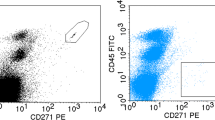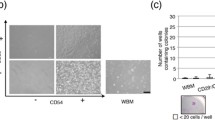Abstract
Non-adherent bone marrow-derived cells (NA-BMCs) are a mixed cell population that can give rise to multiple mesenchymal phenotypes and that facilitates hematopoietic recovery. We characterized NA-BMCs by flow cytometry, fibroblast colony-forming units (CFU-f), real-time PCR, and in in vivo experiments. In comparison to adherent cells, NA-BMCs expressed high levels of CD11b+ and CD90+ within the CD45+ cell fraction. CFU-f were significantly declining over the cultivation period, but NA-BMCs were still able to form CFU-f after 5 days. Gene expression analysis of allogeneic NA-BMCs compared to bone marrow (BM) indicates that NA-BMCs contain stromal, mesenchymal, endothelial cells and monocytes, but less osteoid, lymphoid, and erythroid cells, and hematopoietic stem cells. Histopathological data and analysis of weight showed an excellent recovery and organ repair of lethally irradiated mice after NA-BMC transplantation with a normal composition of the BM.







Similar content being viewed by others
Abbreviations
- NA-BMCs:
-
Non-adherent bone marrow-derived cells
- CFU-f:
-
Fibroblast colony forming units
- HSC:
-
Hematopoietic stem cells
- TTG mice:
-
Triple trangenic mice
- BMCs:
-
Bone marrow cells
- HSCT:
-
Hematopoietic stem cell transplantation
- GvHD:
-
Graft versus host disease
- MSC:
-
Mesenchymal stem cells
References
Zhang ZL, Tong J, Lu RN, Scutt AM, Goltzman D, Miao DS (2009) Therapeutic potential of non-adherent BM-derived mesenchymal stem cells in tissue regeneration. Bone Marrow Transplant 43:69–81
Fricke S, Ackermann M, Stolzing A, Schimmelpfennig C, Hilger N, Jahns J, Hildebrandt G, Emmrich F, Ruschpler P, Pösel C, Kamprad M, Sack U (2009) Allogeneic non-adherent bone marrow cells facilitate hematopoietic recovery but do not lead to allogeneic engraftment. PLoS One 4:e6157
Jiang Y, Jahagirdar BN, Reinhardt RL, Schwartz RE, Keene CD, Ortiz-Gonzalez XR, Reyes M, Lenvik T, Lund T, Blackstad M, Du J, Aldrich S, Lisberg A, Low WC, Largaespada DA, Verfaillie CM (2002) Pluripotency of mesenchymal stem cells derived from adult marrow. Nature 418:41–491
Zhang ZX, Wang RZ, Li GL, Dou WC, Li SF, Wei JJ, Wei YK, Zhao FF, Kong YG, Wu HT, Fan M (2006) Study on trans-differentiation of adult human myoblasts into neural precursor cells and its implantation in rats. Zhonghua Yi Xue Za Zhi 86:2756–2760
Clarke E, McCann SR (1991) Stromal colonies can be grown from the non-adherent cells in human long-term bone marrow cultures. Eur J Haematol 46:296–300
Scutt A, Zeschnigk M, Bertram P (1995) PGE2 induces the transition from non-adherent to adherent bone marrow mesenchymal precursor cells via a cAMP/EP2-mediated mechanism. Prostaglandins 49:383–395
Ferrari G, Cusella-De AG, Coletta M, Paolucci E, Stornaiuolo A, Cossu G, Mavilio F (1998) Muscle regeneration by bone marrow-derived myogenic progenitors. Science 279:1528–1530
Wlodarski KH, Galus R, Wlodarski P (2004) Non-adherent bone marrow cells are a rich source of cells forming bone in vivo. Folia Biol (Praha) 50:167–173
Laub R, Dorsch M, Meyer D, Ermann J, Hedrich HJ, Emmrich F (2000) A multiple transgenic mouse model with a partially humanized activation pathway for helper T cell responses. J Immunol Methods 246:37–50
Laub R, Dorsch M, Wenk K, Emmrich F (2001) Induction of immunologic tolerance to tetanus toxoid by anti-human CD4 in HLA-DR3(+)/human CD4(+)/murine CD4(−) multiple transgenic mice. Transplant Proc 33:2182–2183
Pierelli L, Bonanno G, Rutella S, Marone M, Scambia G, Leone G (2001) CD105 (endoglin) expression on hematopoietic stem/progenitor cells. Leuk Lymphoma 42:1195–1206
Fonsatti E, Del Vecchio L, Altomonte M, Sigalotti L, Nicotra MR, Coral S, Natali PG, Maio M (2001) Endoglin: an accessory component of the TGF-beta-binding receptor-complex with diagnostic, prognostic, and bioimmunotherapeutic potential in human malignancies. J Cell Physiol 188:1–7
Duff SE, Li C, Garland JM, Kumar S (2003) CD105 is important for angiogenesis: evidence and potential applications. FASEB J 17:984–992
Kawai K, Tsuno NH, Matsuhashi M, Kitayama J, Osada T, Yamada J, Tsuchiya T, Yoneyama S, Watanabe T, Takahashi K, Nagawa H (2005) CD11b-mediated migratory property of peripheral blood B cells. J Allergy Clin Immunol 116:192–197
Ogawa M, Matsuzaki Y, Nishikawa S, Hayashi S, Kunisada T, Sudo T, Kina T, Nakauchi H, Nishikawa S (1991) Expression and function of c-kit in hemopoietic progenitor cells. J Exp Med 174:63–71
Mizrak D, Brittan M, Alison MR (2008) CD133: molecule of the moment. J Pathol 214:3–9
Yin AH, Miraglia S, Zanjani ED, Almeida-Porada G, Ogawa M, Leary AG, Olweus J, Kearney J, Buck DW (1997) AC133, a novel marker for human hematopoietic stem and progenitor cells. Blood 90:5002–5012
Otero DC, Anzelon AN, Rickert RC (2003) CD19 function in early and late B cell development: I. Maintenance of follicular and marginal zone B cells requires CD19-dependent survival signals. J Immunol 170:73–83
Lange C, Li Z, Fang L, Baum C, Fehse B (2007) CD34 modulates the trafficking behavior of hematopoietic cells in vivo. Stem Cells Dev 16:297–304
Nielsen JS, McNagny KM (2009) CD34 is a key regulator of hematopoietic stem cell trafficking to bone marrow and mast cell progenitor trafficking in the periphery. Microcirculation 16:487–496
Gangenahalli GU, Singh VK, Verma YK, Gupta P, Sharma RK, Chandra R, Luthra PM (2006) Hematopoietic stem cell antigen CD34: role in adhesion or homing. Stem Cells Dev 15:305–313
Earl LA, Baum LG (2008) CD45 glycosylation controls T-cell life and death. Immunol Cell Biol 86:608–615
Wiesmann A, Buhring HJ, Mentrup C, Wiesmann HP (2006) Decreased CD90 expression in human mesenchymal stem cells by applying mechanical stimulation. Head Face Med 2:8
Mehta K, Shahid U, Malavasi F (1996) Human CD38, a cell-surface protein with multiple functions. FASEB J 10:1408–1417
Ghosh S, Pendurthi UR, Steinoe A, Esmon CT, Rao LV (2007) Endothelial cell protein C receptor acts as a cellular receptor for factor VIIa on endothelium. J Biol Chem 282:11849–11857
Balazs AB, Fabian AJ, Esmon CT, Mulligan RC (2006) Endothelial protein C receptor (CD201) explicitly identifies hematopoietic stem cells in murine bone marrow. Blood 107:2317–2321
Tang XB, Liu DP, Liang CC (2001) Regulation of the transcription factor GATA-1 at the gene and protein level. Cell Mol Life Sci 58:2008–2017
Ho IC, Vorhees P, Marin N, Oakley BK, Tsai SF, Orkin SH, Leiden JM (1991) Human GATA-3: a lineage-restricted transcription factor that regulates the expression of the T cell receptor alpha gene. EMBO J 10:1187–1192
Pan G, Thomson JA (2007) Nanog and transcriptional networks in embryonic stem cell pluripotency. Cell Res 17:42–49
Ducy P, Desbois C, Boyce B, Pinero G, Story B, Dunstan C, Smith E, Bonadio J, Goldstein S, Gundberg C, Bradley A, Karsenty G (1996) Increased bone formation in osteocalcin-deficient mice. Nature 382:448–452
Ito M, Anan K, Misawa M, Kai S, Hara H (1996) In vitro differentiation of murine Sca-1+Lin− cells into myeloid, B cell and T cell lineages. Stem Cells 14:412–418
Bradfute SB, Graubert TA, Goodell MA (2005) Roles of Sca-1 in hematopoietic stem/progenitor cell function. Exp Hematol 33:836–843
Laub R, Dorsch M, Wedekind D, Meyer D, Schroder S, Ermann J, Lehmann J, Mahler M, Emmrich F, Hedrich HJ (1999) Replacement of murine by human CD4 and introduction of HLA-DR17 in mice: a triple-transgenic animal model to study human MHC II-CD4 interaction in situ. J Exp Anim Sci 39:122–135
Dobson KR, Reading L, Haberey M, Marine X, Scutt A (1999) Centrifugal isolation of bone marrow from bone: an improved method for the recovery and quantitation of bone marrow osteoprogenitor cells from rat tibiae and femurae. Calcif Tissue Int 65:411–413
Tschetter JR, Mozes E, Shearer GM (2000) Progression from acute to chronic disease in a murine parent-into-F1 model of graft-versus-host disease. J Immunol 165:5987–5994
Cooke KR, Hill GR, Crawford JM, Bungard D, Brinson YS, Delmonte J Jr, Ferrara JL (1998) Tumor necrosis factor- alpha production to lipopolysaccharide stimulation by donor cells predicts the severity of experimental acute graft-versus-host disease. J Clin Invest 102:1882–1891
Vela-Ojeda J, Montiel-Cervantes L, Granados-Lara P, Reyes-Maldonado E, Garcia-Latorre E, Garcia-Chavez J, Majluf-Cruz A, Mayani H, Borbolla-Escoboza JR, Garcia-Ruiz EM (2009) Role of CD4+, CD25+, highFoxp3+, CD62L+ regulatory T cells and invariant NKT cells in human allogeneic hematopoietic stem cell transplantation. Stem Cells Dev. doi:10.1089/scd.2005.14.310
Orasch C, Weisser M, Mertz D, Conen A, Heim D, Christen S, Gratwohl A, Battegay, M, Widmer A, Fluckiger U (2009) Comparison of infectious complications during induction/consolidation chemotherapy versus allogeneic hematopoietic stem cell transplantation. Bone Marrow Transplant. doi:10.1038/bmt.2009.187
Fuhrer M, Claviez A, Klein B, Humpe A, Schrauder A (2009) Re-transplantation from the same unrelated donor in three adolescents with severe aplastic anemia after graft rejection. Klin Padiatr 221:358–361
Gratwohl A, Baldomero H (2009) Trends of hematopoietic stem cell transplantation in the third millennium. Curr Opin Hematol 16:420–426
Tian Y, Deng YB, Huang YJ, Wang Y (2008) Bone marrow-derived mesenchymal stem cells decrease acute graft-versus-host disease after allogeneic hematopoietic stem cells transplantation. Immunol Invest 37:29–42
Kuhn NZ, Tuan RS (2009) Regulation of stemness and stem cell niche of mesenchymal stem cells: implications in tumorigenesis and metastasis. J Cell Physiol 222:268–277
Le BK, Frassoni F, Ball L, Locatelli F, Roelofs H, Lewis I, Lanino E, Sundberg B, Bernardo ME, Remberger M, Dini G, Egeler RM, Bacigalupo A, Fibbe W, Ringden O (2008) Mesenchymal stem cells for treatment of steroid-resistant, severe, acute graft-versus-host disease: a phase II study. Lancet 371:1579–1586
Hansen W, Westendorf AM, Buer J (2008) Regulatory T cells as targets for immunotherapy of autoimmunity and inflammation. Inflamm Allergy Drug Targets 7:217–223
Hoffmann P, Ermann J, Edinger M (2005) CD4+CD25+ regulatory T cells in hematopoietic stem cell transplantation. Curr Top Microbiol Immunol 293:265–285
Blache C, Chauvin JM, Marie-Cardine A, Contentin N, Pommier P, Dedreux I, Francois S, Jacquot S, Bastit D, Boyer O (2009) Reduced frequency of regulatory T cells in peripheral blood stem cell as compared to bone marrow transplants. Biol Blood Marrow Transplant. doi:10.1016/j.bbmt.2009.10.027
Edinger M (2008) CD4+CD25+ regulatory T cells approach the clinic. Cytotherapy 10:655–656
Chroma Werksschrift (1962) Ausgewählte Färbemethoden für Botanik, Parasitologie, Zoologie, Chroma-Ges. Schmid, Stuttgart-Untertürkheim
Acknowledgments
We thank Mr. Jan Matthias Braun, PhD, Translational Centre for Regenerative Medicine, Universität Leipzig and his colleagues for providing and breeding the triple transgenic (TTG) mice, Ms. Stephanie Tuche and Ms. Ramona Blaschke for preparation of the histological slides, Mr. Guido Hildebrandt for preparing irradiation of recipient mice, and Ms. Manuela Ackermann for preparing flow cytometry. The work presented in this paper was funded by the German Federal Ministry of Education and Research (BMBF 0313452, PtJ-Bio, 0313909).
Author information
Authors and Affiliations
Corresponding author
Rights and permissions
About this article
Cite this article
Fricke, S., Fricke, C., Oelkrug, C. et al. Characterization of murine non-adherent bone marrow cells leading to recovery of endogenous hematopoiesis. Cell. Mol. Life Sci. 67, 4095–4106 (2010). https://doi.org/10.1007/s00018-010-0427-2
Received:
Revised:
Accepted:
Published:
Issue Date:
DOI: https://doi.org/10.1007/s00018-010-0427-2




